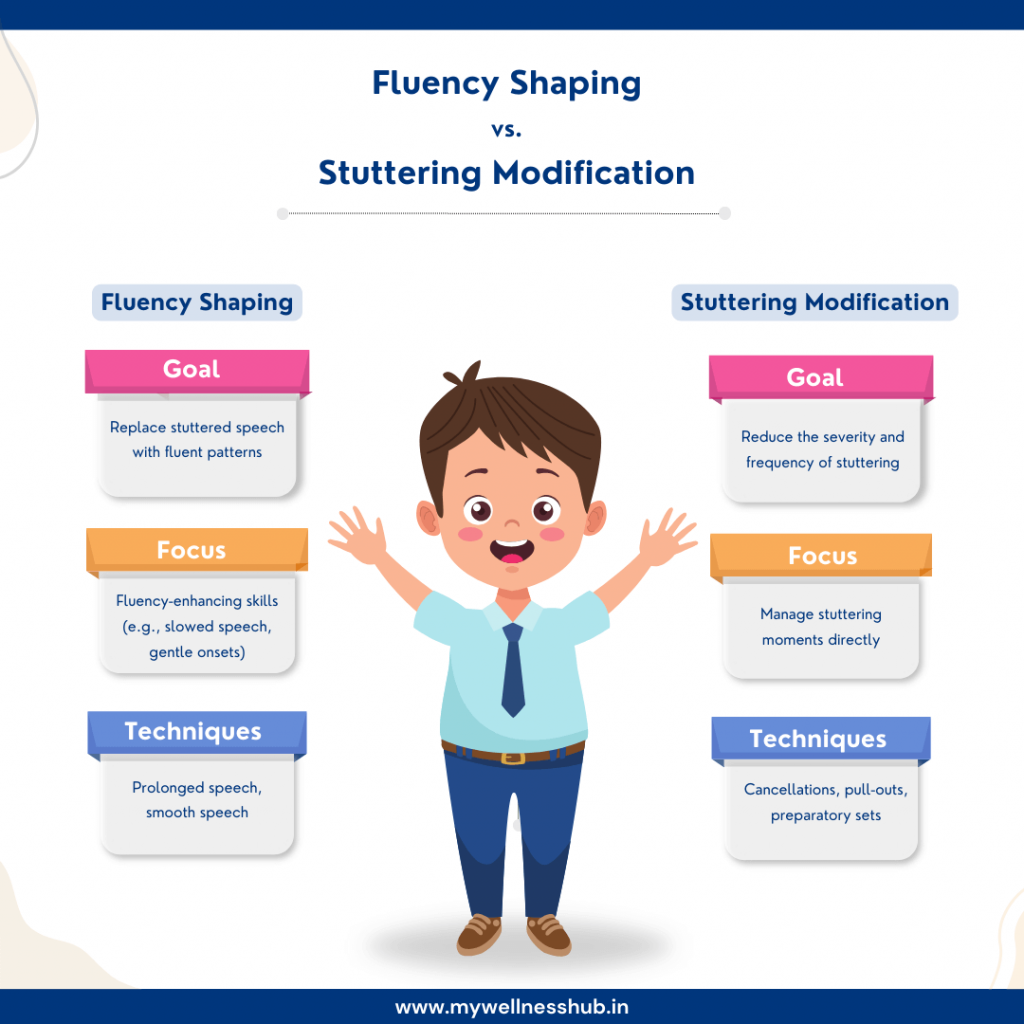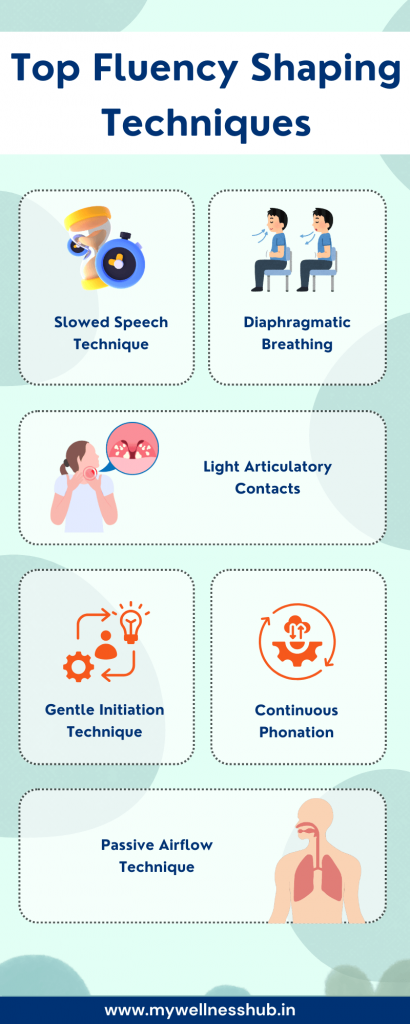Fluency Shaping Tips and Techniques to Overcome Stuttering
Last Updated: August 12, 2024
Stuttering is more than just a speech disorder. It’s a challenge that can affect everyday life, making it difficult to communicate confidently and fluently. For many individuals who struggle with stuttering, the journey toward fluent speech can feel like a steep climb. Words get stuck, phrases become tangled, and conversations often seem like a daunting task. But there’s hope in finding ways to speak more smoothly and clearly.
Fluency shaping is a proven approach to managing stuttering and enhancing fluency. It’s a set of techniques designed to help replace stuttered speech with fluent speech patterns, enabling individuals to communicate with greater ease and confidence. While not all cases of stuttering can be completely cured, fluency shaping strategies offer practical tools to significantly reduce the impact of stuttering on everyday conversations.
Understanding Fluency Shaping
Definition and History
Fluency shaping is a speech therapy approach aimed at replacing stuttered speech with fluent speech patterns. The primary objective is to help individuals who stutter speak more smoothly and confidently by teaching new speech patterns and techniques. Instead of focusing on individual stuttering moments, fluency shaping encourages a complete transformation of speech behavior, emphasizing fluency-enhancing skills such as:
- Slow Speech Rate: Reducing the speed of speaking to improve control over speech.
- Gentle Onsets: Easing into words to prevent stuttering blocks.
- Continuous Phonation: Maintaining a steady airflow during speech to reduce disruptions.
The history of fluency shaping dates back to the mid-20th century when researchers began to explore more structured techniques for improving speech fluency. It evolved as a direct response to the limitations of previous therapies, which focused primarily on reducing the emotional distress associated with stuttering.
Also Read: Understanding Stuttering: Causes, Impact, & Treatment
Difference Between Fluency Shaping and Stuttering Modification

While both fluency shaping and stuttering modification aim to help individuals who stutter improve their speech, they differ in their approach and focus:
- Fluency Shaping
- Objective: Replacing stuttered speech with fluent speech patterns.
- Focus: Teaching new speech patterns (e.g., slow rate, gentle onsets).
- Techniques:
- Prolonged Speech: Stretching out vowels to improve fluency.
- Smooth Speech: Blending words together seamlessly.
- Stuttering Modification
- Objective: Reducing the severity and frequency of stuttering.
- Focus: Managing stuttering moments directly.
- Techniques:
- Cancellations: Stopping after a stuttered word and repeating it fluently.
- Pull-outs: Modifying a stuttered word while it’s happening.
- Preparatory Sets: Preparing for difficult words with gentle onsets.
Fluency shaping primarily focuses on enhancing fluent speech patterns, making it easier for individuals to speak smoothly. In contrast, stuttering modification directly addresses stuttering moments by teaching techniques to manage and lessen their impact.
Know more: 7 Key Techniques for Overcoming Stuttering
Top Fluency Shaping Tips and Techniques
Step-by-Step Guide to Better Fluency
To make significant progress with fluency shaping, it’s essential to work with a Speech-Language Pathologist (SLP) or utilize guided tools like the Wellness Hub app. An SLP can personalize techniques to your specific needs and help track your progress effectively. Here are some of the top fluency shaping techniques to incorporate into your stuttering management plan:

1. Slowed Speech or Stretched Syllable Technique
Description: The slowed speech technique involves speaking deliberately at a rate of 40-60 syllables per minute, stretching each syllable to improve speech control.
How to Practice:
- Break words into syllables (e.g., “le-mon”).
- Stretch each syllable for 2 seconds, but avoid stretching unvoiced sounds like B, D, G, or T.
- Gradually increase your speaking rate under the guidance of an SLP until you reach a normal conversational speed.
2. Diaphragmatic Breathing
Description: Diaphragmatic breathing, also known as abdominal breathing, helps relax vocal muscles and gain control over breathing patterns.
How to Practice:
- Place one hand on your chest and the other on your belly.
- Breathe deeply, feeling your belly rise, then relax to feel it fall.
- Use this technique to calm the vocal muscles and prepare for speech.
3. Light Articulatory Contacts
Description: Light articulatory contacts involve gentle touches with articulators (lips, vocal cords) to minimize speech blocks.
How to Practice:
- Identify the articulators pronouncing specific words (e.g., lips for “ball”).
- Make a light touch with the articulator before pronouncing the word.
4. Gentle Initiation Technique
Description: The gentle initiation technique requires starting speech with soft vocal cord vibrations to ease vocal tension.
How to Practice:
- Start with a low-volume voice, gradually increasing to a normal level.
- Apply this technique to each syllable and slowly decrease the volume after speaking.
5. Passive Airflow Technique
Description: Passive airflow involves releasing a small amount of air before speaking to relax the vocal cords and reduce speech blocks.
How to Practice:
- Take a deep breath (using diaphragmatic breathing).
- Release a small passive exhale.
- Start speaking using the stretched syllable technique.
6. Continuous Phonation
Description: Continuous phonation maintains constant vocal vibrations while speaking to reduce breaks between words and improve speech fluency.
How to Practice:
- Focus on your articulators and maintain continuous airflow.
- Reduce pauses between words, but avoid rushing through your speech.
Fluency Shaping Techniques and Objectives
| Technique | Objective | Practice Tips |
|---|---|---|
| Slowed Speech (Stretched Syllable Technique) | Slow down speech rate to improve speech control. | – Speak at 40-60 syllables per minute, stretching each syllable for about 2 seconds. – Gradually increase the speaking rate under the guidance of an SLP. – Stretch each syllable, avoiding unvoiced sounds like /p/, /t/, and /k/. |
| Diaphragmatic Breathing | Relax breathing to ease vocal tension. | – Place one hand on your chest and the other on your belly. – Breathe deeply into your abdomen, feeling the belly rise with each breath. – Exhale slowly, relaxing your vocal muscles. – Practice for 5 minutes daily to promote relaxation and reduce vocal tension. |
| Light Articulatory Contacts | Make gentle touches to minimize speech blocks. | – Identify the articulators (tongue, lips, etc.) involved in pronouncing specific sounds. – Practice light touches with your lips or vocal cords to avoid tension blocks. – Use minimal contact for consonants, especially /p/, /b/, /t/, /d/, /k/, and /g/. |
| Gentle Initiation (Easy Onset Technique) | Start speech softly to reduce vocal cord tension. | – Begin phonation with soft vocal cord vibrations to ease vocal tension. – Use “h” sounds to start words gently (e.g., “hhhh-apple”). – Gradually increase vocal volume to a normal level. – Decrease volume slowly after speaking. |
| Passive Airflow (Airflow Technique) | Relax vocal cords before speaking to prevent blocks. | – Take a deep diaphragmatic breath. – Release a small passive exhale before speaking. – Start speaking using the stretched syllable technique. – Maintain a steady and relaxed airflow throughout the speech. |
| Continuous Phonation | Maintain airflow to reduce pauses and breaks. | – Focus on keeping your vocal cords vibrating throughout the speech. – Minimize pauses by linking words with “and,” “but,” “so,” etc. – Practice reading aloud while maintaining continuous phonation. – Gradually reduce pauses between words, but avoid rushing your speech. |
Read more: 12 Effective Stuttering Exercises for Adults at Home
Long-term Impact of Fluency Shaping
Neuroplasticity and Speech Fluency
Fluency-shaping techniques can profoundly impact the brain, particularly by enhancing the auditory-to-motor pathways responsible for speech fluency. Through consistent practice, individuals who stutter can rewire their brains, strengthening connections between the regions involved in hearing, speech production, and motor control.
Know more: Neurogenic Stuttering vs Psychogenic Stuttering: Key Differences Explained.
Practice and Consistency
To achieve these long-term benefits, practice, and consistency are crucial. Applying fluency shaping techniques regularly can help you:
- Reinforce New Speech Patterns
- Daily practice makes techniques like slowed speech, diaphragmatic breathing, and gentle initiation more natural.
- Increase Confidence
- Practicing fluency shaping techniques consistently builds confidence in speaking situations, reducing the fear of stuttering.
- Track Progress
- Consistent practice allows you to monitor improvements and identify areas that need more focus.
Daily Fluency Shaping Practice Plan
| Technique | Practice Time | Detailed Instructions |
|---|---|---|
| Slowed Speech | 10 minutes | Begin by speaking at a controlled pace of 40-60 syllables per minute. Focus on stretching each syllable for a consistent duration, ensuring clarity and control throughout your speech practice. |
| Diaphragmatic Breathing | 5 minutes | Place one hand on your chest and the other on your belly. Take deep breaths to fully expand your belly, promoting relaxation in your vocal muscles, crucial for reducing tension during speech. |
| Light Articulatory Contacts | 5 minutes | Practice making gentle contacts with your lips or vocal cords. This involves lightly touching these articulators to produce sounds, which helps in reducing harsh blocks and abrupt starts. |
| Gentle Initiation | 5 minutes | Initiate speech with soft vocal cord vibrations, starting at a low volume. Gradually increase the volume to a normal speaking level, focusing on smooth transitions without abruptness. |
| Passive Airflow | 5 minutes | Take a deep, relaxing breath, then release a small, passive exhale just before you begin to speak. This helps relax the vocal cords and prepares them for smoother speech initiation. |
| Continuous Phonation | 10 minutes | Work on maintaining a constant flow of air through your vocal cords while speaking. Aim to reduce breaks and pauses, ensuring a smoother transition between words and sounds. |
Conclusion
Fluency shaping techniques can greatly improve speech fluency for those who struggle with stuttering. By using strategies like slowed speech, diaphragmatic breathing, gentle initiation, or continuous phonation, you can replace stuttered speech with smoother and more confident communication. The key to success is daily practice and consistency, which will help your brain build stronger connections that support fluent speech.
However, seeking professional guidance can help you make even better progress. A Speech-Language Pathologist or the Wellness Hub can offer personalized support to guide you. Our speech therapy services are designed to help you reach your goals and empower you along the way. Remember, fluency shaping is not a quick fix, but with dedication and patience, you can achieve the fluent speech you’ve always wanted.
Frequently Asked Questions:
1. What is fluency shaping therapy for stuttering?
Fluency shaping therapy aims to help people who stutter speak more fluently by replacing stuttered speech with fluent patterns through techniques like slowed speech, gentle initiation, and continuous phonation.
2. How is fluency shaping different from stuttering modification?
Fluency shaping focuses on enhancing fluent speech patterns, while stuttering modification involves managing stuttering moments directly by confronting and reducing their severity.
3. Which fluency shaping techniques are most effective for overcoming stuttering?
- The most effective techniques include:
- Slowed Speech Technique
- Diaphragmatic Breathing
- Light Articulatory Contacts
- Gentle Initiation Technique
- Passive Airflow Technique
- Continuous Phonation
4. How often should I practice fluency shaping techniques to improve my speech?
Consistent daily practice is key to improvement. Start with a daily fluency shaping practice plan and consider working with a speech-language pathologist or using the Wellness Hub app for guided practice.
5. Can fluency shaping techniques rewire the brain for better speech fluency?
Yes, fluency shaping can improve speech fluency through neuroplasticity by enhancing the auditory-to-motor pathways in the brain.
6. How does diaphragmatic breathing help with stuttering?
Diaphragmatic breathing relaxes your vocal muscles and helps control breath flow, reducing tension that can lead to stuttering.
7. What is the slowed speech or stretched syllable technique for stuttering?
This technique involves slowing down your speech to 40-60 syllables per minute and stretching each syllable to make speech more deliberate and fluent.
8. Is fluency shaping therapy effective for children who stutter?
Yes, fluency shaping techniques like slowed speech and passive airflow can be particularly helpful for children who stutter. Find out how to help your child thrive with speech therapy.
9. How can I maintain consistent progress with fluency shaping techniques?
Regular practice with a daily fluency shaping practice plan is crucial. Collaborate with a speech-language pathologist or use the Wellness Hub app to monitor your progress.
10. Where can I find online speech therapy for stuttering?
Wellness Hub provides online speech therapy for individuals seeking fluency shaping tips and guidance for overcoming stuttering.
About the Author:
Anuradha Karanam
Speech-language pathologist (7+ years of experience)
Anuradha Karanam is a skilled speech-language pathologist with over 6 years of experience. Fluent in Tamil, Telugu, Hindi, and English, she specializes in parent counseling, speech sound disorders, fluency assessment, and speech-language evaluations. Anuradha excels at working with children with developmental disorders, offering creative and effective therapy programs. Currently, at Wellness Hub, she holds a BASLP degree and is registered with the RCI (CRR No A85500). Her patience, ambition, and dedication make her a trusted expert in her field.
Book your Free Consultation Today
Parent/Caregiver Info:
Client’s Details:
* Error Message









